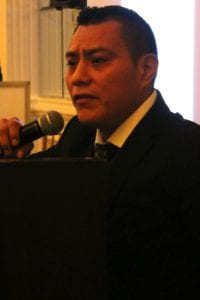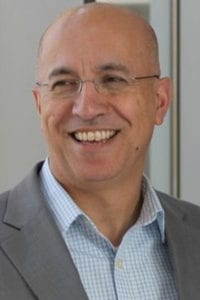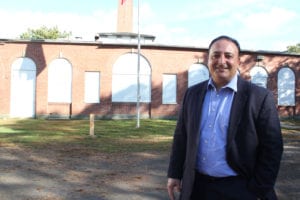By Kevin Redding
In 2006, a year after he was elected Suffolk County sheriff, Vincent DeMarco took a huge risk. In an effort to reduce gang violence in the Riverhead correctional facility, DeMarco brought a seemingly ill-fated program into the jail where rival gang leaders and members — Bloods, Crips, MS-13, Latin Kings and Aryan Brotherhood — gather in a room to share stories, make peace and help one another escape a life of crime. In doing so, Riverhead became the first county jail in the nation to embrace Council for Unity, a nonprofit founded in Brooklyn in 1975 to keep gang activities out of schools and communities and replace a culture of despair with a culture of hope. The newly-appointed sheriff’s gamble quickly paid off.

In a matter of months, DeMarco and correctional facility members watched the entire jail system turn around, as inmates who came to the prison as enemies began to form friendships through their similar experiences. The men, many of whom are imprisoned for violent behavior and drug dealing, find careers after they’ve served their sentences thanks to job and education opportunities offered in the program.
Inmate population and the rate of recidivism at Riverhead are now at an all-time low and the jail serves as a model for other correctional facilities statewide. The Riverhead Police Department has since developed its own companion anti-gang program with the organization.
“DeMarco has changed the dynamic in that facility and has created hope for inmates who live without hope,” said Robert DeSena, president and founder of Council For Unity, who met with DeMarco and his staff to pitch the radical concept in February 2006. “He has a tremendous social conscience and his perception of incarcerated people is atypical. He saw they had the capacity to be reclaimed and he went with it.”
DeSena and others involved in the program, including ex-gang members, honored DeMarco for his significant impact surrounding these criminals’ rehabilitation during Council For Unity’s annual Champions for Children Gala at the Garden City Hotel Nov. 9.
“I had this smirk on my face as if to say to ‘this guy is nuts. You’re going to get Crips and everybody together Kumbaya-ing? That’s not happening here. But Sheriff DeMarco is somebody who’s willing to take a chance. And let me tell you, it was worth a chance. I love this man.”
— Butch Langhorn
The annual event aims to celebrate public figures on Long Island active in the reduction of gang violence in society. DeMarco, who has served as sheriff for 12 years and decided earlier this year he would not seek a fourth term, was on the short list of honorees alongside Nassau County District Attorney Madeline Singas and Council for Unity alumnus Dr. James Li.
He received a plaque referring to him as a visionary, reformer and humanitarian “for creating a climate of hope and possibility for the inmates in his charge.”
While introducing DeMarco to receive his honor, Butch Langhorn, assistant to the sheriff who oversees the Council For Unity sessions at the jail, recalled the first meeting he and DeMarco had with DeSena.
“While we were listening, I had this smirk on my face as if to say to ‘this guy is nuts,’” Langhorn said. “You’re going to get Crips and everybody together Kumbaya-ing? That’s not happening here. But Sheriff DeMarco is somebody who’s willing to take a chance. And let me tell you, it was worth a chance. I love this man.”
During his 2005 campaign, DeMarco advocated for more programs that aimed to work with inmates and provide opportunities to change their lives. This came in response to a New York State mandate at the time to build a new $300 million correctional facility in Suffolk as the county was pushing 1,800 to 2,000 inmates per day. He was determined to not only lower the population, but make sure the inmates were working toward a goal beyond bars.
“I thought, this is corrections and we’re supposed to correct their behavior,” DeMarco said at the podium. “The facility isn’t about warehousing people and just putting them back into the same situation they came from.”
Although he admitted being skeptical of the idea of intermingling gang members at first, fearing it would only lead to more violence, the sheriff said he left the meeting with DeSena fully on board.

“He did this Jedi mind trick on me and I was spun around,” DeMarco said laughing. “I just kept thinking, ‘this could work, this could work.’ It was the right thing to do and we’ve come a long way. A couple people who went through the program are out now and they’re getting paychecks, they’re married. [The program] got them out of gang culture. That warms my heart and makes it all worthwhile for me. I know we’ve helped change people’s lives, so this is a big honor for me. You always seem to remember the first and last thing you did in a position and Bob was the first meeting I ever took and now there’s this. It’s a nice little cap off.”
Mario Bulluc, 22, who was an MS-13 leader when he was a student at Riverhead High School and now serves as an employee of the council, sought refuge in the program after countless close calls with death and time spent in the Riverhead jail. He now devotes his life to helping kids get out of gangs.
“Council For Unity saved my life — DeMarco and DeSena are the greatest men I’ve ever met,” said Bulluc, who joined the infamous gang when he was 14. “They try and get to the root of our problems and help us see we are the same people no matter our race, gang, or gang colors. If I can change, anybody can.”
Alex Bryant, a retired corrections officer at Riverhead and a Council For Unity advisor, said the council was put to the test in the correctional facility and has been proven to be life-changing. He pointed to DeMarco’s leadership as the reason for its success.
“I’ve been under several sheriffs in my 30-year tenure in the field,” Bryant said. “DeMarco is by far the best. He is progressive and eons ahead of most sheriffs across the state of New York.”























